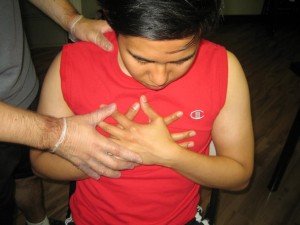A heat stroke is a condition that is caused by the overheating of the body, usually due to prolonged exposure to the sun or some physical exertion in high temperatures. A heatstroke can occur if the temperature of the body rises to 104 degrees F (40 degree centigrade) or even higher.
Heatstroke requires emergency care since if not treated, may result damage on the brain, kidney, heart and muscles. The damage will worsen if the treatment is delayed, and there is a risk of a serious complications or even death.
[youtube url=”https://www.youtube.com/watch?v=AACwAleDkN0″ width=”220″]Symptoms of heat stroke
- A rectal temperature of over 104 degrees F (40 degrees C) after exposure to the sun
- Headaches
- Confusion, dizziness and disorientation
- Fatigue
- There are signs of a moderate to severe difficulty in breathing
- The color of the skin is red, hot, and dry as well as in the armpits
- Fast heart beat
- Low blood pressure
- Heavy sweating
- Irritability
- Lack of consciousness for a few seconds
- Severe vomiting
How to prevent heat stroke from happening

- Avoiding outdoor activities under severe heat. Be careful while being exposed to the sun. Bring umbrellas or wear a hat when walking under the sun.
- Avoid a midday heat and do not engage in vigorous activities during the hottest part of the day from 11:00 a.m. to 4:00 p.m.
- Do not stay or leave anyone in a closed parked vehicle during hot weather.
- When working outdoors, drink plenty of water and avoid drinking alcohol, coffee and soda.
- Wear clothes that are light weight, light-colored and loose-fitting. They should be made of cotton.
- When engaging in outdoor activities, splash your body frequently with water.
- If inside a room and feeling very hot, open the windows or use a fan or use an air-conditioned to cool off
First aid and emergency treatment for heat stroke
- Transfer the individual to a cool place and without sunlight
- Remove all unnecessary clothing of the person and place the person on his/her side to expose the entire skin surface to air as possible.
- Sponge with cool water the entire body of the person to minimize the heat of the body.
- Another way is spray cool water on the person to lower the body temperature.
- Put some ice packs to the groin, neck and armpits of the person.
- Check the person’s rectal temperature from time to time. Try to make the temperature to 102 degrees F (39 degrees C) or even lower.
- If the person suffering from heatstroke stops breathing, perform rescue breathing.
- If the person is conscious help him to sit up and let him or her drink fluids. Give the person 1 to 2 liters of water over a period of 1 to 2 hours for hydration.
Tips and warning
Do not immerse the person suffering from heat stroke in an ice bath and do not give aspirin or acetaminophen in reducing a high body temperature due to heat stroke since it may cause unnecessary complications.
